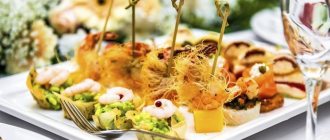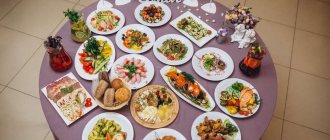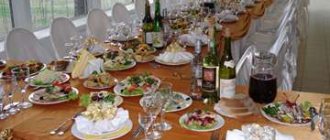A banquet is a responsible ceremonial event, the organization of which requires a careful approach. This could be a birthday party, wedding catering, business dinner or graduation. Regardless of the type of celebration, one of the most important stages of preparation for it is drawing up a banquet menu. His correct choice is already almost half of a successful holiday.
Banquet calculator
i We work in Moscow and within a radius of 200 km from Moscow
Banquet calculation
Banquet menu example
The following ratio of main courses and snacks on the banquet table is considered optimal:
- Cold appetizers - 3–6 items.
- Salads - 1–3 types.
- Hot appetizers - 2–4 items.
- Main courses - 1-2 types.
- Side dishes.
- Bakery.
- Desserts - 2 types.
- Fruits.
- Beverages.
Cold appetizers: what to choose?
Favorites on the festive table are various sets of meat and fish appetizers, assorted pickles and sausages, quartets of cheeses, canapés, mini sandwiches, stuffed vegetables, bruschetta, etc.
Popular salads.
As a rule, the menu includes dishes prepared according to traditional recipes (“Olivier”, “Greek”) and more refined options. Among our clients, “Salad with chicken fillet baked in spices, orange segments, celery with nut sauce” is especially popular.
We choose the main dishes.
A variety of culinary masterpieces from meat, poultry and fish are the basis of the menu, as they are the most nutritious. Chops, schnitzels and steaks are especially popular. Our customers also often order whole baked fish or poultry.
Delicious pastries.
We offer hot, fragrant, tender and rosy products (pies, buns, cookies) that will become a worthy decoration for your holiday table.
The most delicious desserts.
At celebrations such as weddings and birthdays, there will definitely be a cake. In addition to it, portioned treats would be appropriate, for example, chocolates and marmalade, cupcakes and muffins, and tartlets.
Drinks: what is in demand?
Among cold drinks, the most popular are mineral water, juices, lemonades, and fruit drinks. Hot drinks - tea, coffee - are also in demand.
The cost of a festive banquet depends on the level of service and in Moscow will amount, on average, to 3,000 rubles per guest.
Choosing dishes
There are many tips on how to properly create a banquet menu for a wedding. The first step is to accurately approve the final guest list. All people included in it should be called about a week after the invitations are presented to find out who exactly will not be able to come to the celebration. With the resulting number of guests, you can already go to a cafe or restaurant to order a specific banquet for a specific date.
In addition, it is necessary to first go through the list, even if there are more than 100 people on it, to determine how many of them are men, women and children. Looking at the list of guests, you come to an understanding of what menu you can create for your wedding.
Portions are usually slightly larger for the male half, medium for women, and small for children. In addition, it is advisable to distribute guests according to tastes, that is, determine who likes what most in order to find universal solutions for the menu.
The guest list also helps in highlighting certain groups, for example, children of vegetarians, allergy sufferers, fasting people, diabetics, etc. Such people can be concentrated in one place in order to place individual dishes at a specific table.
Interesting! Find out the best salad recipes for a wedding, as well as ideas for delicious cold appetizers.
Children are most often seated separately so that they do not get bored among the adults. The menu for kids is less caloric, but the number of desserts is increased. When selecting suitable dishes, the time of year for which the celebration is scheduled is also taken into account.
In summer and early autumn, the season for country fruits and vegetables begins, so you can safely use them in the menu - fresh fruits will give a rich taste and allow you to save a little.
In late autumn and winter, dishes should be mostly meat or fish, since the food should be nourishing and nutritious. For drinks, you can give preference to hot tea, coffee, cocoa, classic or non-alcoholic mulled wine.
In spring, you need to try to replenish the supply of vitamins for all guests, so the dishes are supplemented with greenhouse vegetables and a lot of herbs.
Types of banquets
- Business.
Typically does not last long and requires foods that can be easily eaten. - Corporate.
The most popular dishes include small cold and simple hot appetizers. - High school graduation.
The banquet menu includes a variety of appetizers, pickles, drinks, serving 2-3 main courses, a rich “sweet” table and additional “tricks”, for example, a chocolate fountain. - Wedding.
In this case, the menu should be designed in such a way that guests have the opportunity to try all the dishes, can enjoy various foods throughout the celebration and, of course, do not remain hungry. - Anniversary date.
The menu for such a banquet can be themed.
How to organize a good banquet?
The basis for success is proper planning .
1. We determine the desired date and time of the banquet, the number and “qualitative composition” of guests. The better you understand when and for whom you are organizing the event, the more successful everything will be. Try to determine how many men and how many women will be in the company, the average age of the guests, what the gastronomic and alcoholic preferences of the guests are, what the initial mood of the banquet participants will be. It’s best to decide with a pencil in your hands: write, analyze, correct, supplement, analyze again...
Let's say it works out for you: Saturday, 16:00, cheerful and cheerful relatives (60 people, men and women approximately equally, average age 45 years) come to congratulate the newlyweds. This means that a separate spacious room will be required to not only set up tables for 60 people, but also leave room for dancing. They will eat and drink a lot. You will need good lighting to get high-quality video footage, a microphone for the presenter and speakers...
Or a completely different example: Friday, 19:00, a group of design engineers (20 people, only 2 women, all 30-35 years old, from different cities, not very familiar with each other) is going (or rather, the organizers are taking them) to a restaurant to celebrate completion of the 5-day seminar. If you rent a separate room for this banquet, turn on calm music and put a lot of strong alcoholic drinks on the table, you are likely to end up with a half-asleep kingdom, half-listening to the professional argument of two or three of the most talkative banquet participants. And if you don’t overload the table with food or alcohol, and generally place the banquet in a slightly separate area of the restaurant’s common room, where there will be other people (particularly female) and an incendiary show program, your guests will be able to relieve the stress of a hard week and have fun from everything that is happening.
So, date, time, participants, budget, light, sound, mood - have you presented everything? Let's move on to the next stage.
2. Set the budget for the event. There is a certain minimum standard accepted in restaurants in your city, and an upper limit that depends only on your capabilities (or the capabilities of your company). Find out the first one for reference in restaurants, determine the second one yourself (or ask management). Then subtract 15% from the amount you can spend for unforeseen expenses, divide the rest by the number of guests. And then, having started calling advertisements like “renting a banquet hall” and “organizing the best banquets,” you will be able to clearly say: “Banquet for NN guests, no more than NNNN rubles per person.” Save time and impress your interlocutor as a person who knows exactly what he wants.
By the way, at this stage it may turn out that what you planned in point 1 does not fit into the budget at all. This means we need to go back to planning and cut something. If we are talking about a private event, the number of guests is often reduced. If it’s a corporate event, then it makes sense to first describe your plans to your bosses in spectacular detail and demand an increase in the budget: maybe it will work out...
If the plans and budget come together, it’s time to start searching remotely for a site. Search on the Internet and advertising newspapers, read reviews if possible, call, compare offers with your demand: you should find a couple of suitable places. And go there on reconnaissance in person.
3. We make a menu. You arrived at the restaurant, made sure that the ambience is suitable - which means it’s time to cover the “clearing”. Again, first on paper. The restaurant probably has its own banquet menus, and you can build on them, but take the trouble to calculate how much food one guest is offered to eat. In most cases it will turn out to be unrealistically high. So that you don’t feel painfully sorry for the untouched plates later, I offer this approximate layout for one person:
salads - 150-200 g cold appetizers - 100-150 g hot appetizers - 100-150 g main dish (including side dish) - 300-400 g fruits - 50-100 g
That's all! This will not be enough except for a company consisting entirely of young lumberjacks who have worked well in the cold. It is better to order dessert, tea or coffee as the action progresses; not everyone will need this. All that remains is to add mineral water and juice (1-1.5 liters per person in total) and alcohol.
The latter is very individual for each banquet. You know what and how much your guests drink - great, order it. If you don’t know, try to leave room for maneuver, for example, order a little champagne, white and red wine, vodka and cognac to start the banquet, and add the rest as you go. However, this recommendation is suitable for companies of no more than 30 people, when it is realistic to monitor the situation. For large feasts, everything needs to be planned in advance, and you can go according to the average formula (250-300 g of wine + 150-200 g of strong drinks for each, and then let them figure it out for themselves whether to interfere or not to interfere). For corporate banquets, especially after which everyone goes to work, it is absolutely normal for there to be only light alcohol on the tables.
4. Important little things. Before making your final choice, walk around the restaurant, or better yet, have dinner there, paying attention not only to the quality of food and service, but also to such things as ventilation, wardrobe, toilet, entrances and exits (will there be crowding in a narrow corridor) . Find out what will be happening in the areas near your banquet hall. Finally, determine whether it will be convenient for guests to get to the restaurant, and most importantly, to then go home. Don't let little things ruin your holiday.
Have you thought of everything? This means you can make an advance payment and send out invitations. And may your banquet be a success!
Tags: corporate holiday, celebration, celebration, restaurants, feast, banquet
What to consider?
- Season.
In summer, light food is most preferred - vegetable, fruit, fish dishes. In the cold season, hot snacks made from traditional types of meat (beef, pork, chicken) are preferable. - Number of guests.
The total amount of food is calculated taking into account the norm per guest. - Serving features.
It is better to use portioned salad bowls or tartlets for serving, and common trays for appetizers and cuts. - Special menu.
It is necessary to take into account the presence of children, people with allergies, vegetarians and vegans. To properly create a menu for them, we recommend including alternative options.
Factors to consider when creating a menu
The banquet organizers are faced with the task of providing tasty and satisfying food to the guests, without ordering too much, so as not to overpay.
Please pay attention to the following details:
- The total number of people at the table.
- The age of the guests, since older people prefer traditional treats, and young people willingly try unusual, even exotic dishes.
- If there are many men among the guests, increase the number of hearty meat dishes and strong alcoholic drinks; if there are women, order more light vegetable salads, wine and liqueurs. If there are a lot of children at the party, take care of a children's menu and a sufficient number of sweets.
- Season. In hot summer weather, guests prefer light vegetable snacks and salads, and low-alcohol drinks. In winter, it is better to serve delicious hot dishes and strong alcohol.
- The longer the banquet lasts, the more food and drinks will be required.
Be sure to consider the reason for the celebration. For a golden wedding it is better to offer traditional dishes of Russian and European cuisine, for a coming of age celebration - modern, unusual treats, for a children's birthday - originally designed sandwiches, sandwiches, rolls, sweets, fruits, juices. A wedding is unthinkable without a colorful cake.
Food allowance per person
The final yield of dishes per guest is calculated depending on the duration of the celebration:
| Type of event | Duration | Food (g/person) |
| Business banquets | no more than 1–2 hours | approximately 400 |
| Other events | from 2–4 hours | 600 |
| Graduation, anniversary | 4–6 hours | from 600 to 1200 |
| Wedding | more than 6 hours | 1300–1500 including birthday cake |
The food allowance per person for wedding banquets and long events is:
| Cold appetizers | Salads | Hot appetizers |
| Sliced dishes (meat, fish, cheese, vegetables), pork rolls, jellied, pickled vegetables. | Can be vegetable, fish and meat. | Mini-kebabs (chicken, pork, beef) and spring rolls are popular. |
| 350–400 g/person | 200–250 g/person | 100 g/person |
| Main dishes | Fruit slices | Dessert |
| Meat, fish, seafood. | Exotic and seasonal fruits. | Cakes, cake, sweets, pastries. |
| 250 g/person | 200 g/person | 150–200 g/person |
Total amount: 1400–1500 gr. per person.
Standard list of necessary products for the holiday
We found out how much food you need to order for each guest invited to your holiday. But how to calculate food for a banquet? This is the task of the cook or administrator. They know the exact calculation of dishes and all the ingredients included in them.
Typically, a restaurant or catering service purchases its own products. The client can bring his own fruits, cake, as well as alcohol, juices, and water. Of course, you can save money by putting homemade marinades or regular store-bought bread on the table, but each establishment sets its own rules that you have to take into account. The main thing when purchasing products is their quality, freshness and attractive appearance. Restaurateurs know reliable suppliers who supply quality products at wholesale prices.
What to buy for a banquet table:
- meat and poultry;
- fresh fish;
- potato;
- cereals for garnish;
- sausages, boiled-smoked or dry-cured meat;
- lightly salted, smoked fish;
- pickles - tomatoes, cucumbers, cabbage, mushrooms, olives;
- cheeses;
- nuts;
- eggs;
- fresh vegetables;
- fresh herbs;
- fruits and berries;
- bread;
- ready-made confectionery products or ingredients for preparing signature desserts;
- wine, vodka, cognac, champagne;
- juice, table water with and without carbonation.
Cold appetizers:
- cold smoked fish (sturgeon, halibut, beluga, etc.) - 50-60 g - red salted fish (trout, salmon) - 50-60 g - sandwiches with red caviar - 1-2 pcs - salted herring - 50 -60 g – sliced cheese from smooth cheeses (“Gouda”, “Dutch”, etc.) – 20-30 g – sliced cheese from raw smoked sausage, boiled sausage, boiled pork – 20-30 g – jellied tongue – 40-50 g - canapés with cheese ("Roquefort") - 4-5 pcs - salad with sausage or meat, baked shrimp or salad with shrimp, "Liver" cake, "Greek" salad - 50 g each - fresh greens - 20-30 g - fresh sliced tomatoes and cucumbers - 40-50 g each - pickled and salted mushrooms - 30 g each - tomatoes, pickled or pickled cucumbers - 40-50 g each - pies with mushrooms, meat - 2 pcs - sauerkraut - 40 -50 g - wild garlic, capers, pickled ginger and pickled garlic - 20 g each - olives, olives - 10-20 g each. – butter – 15 gr.











